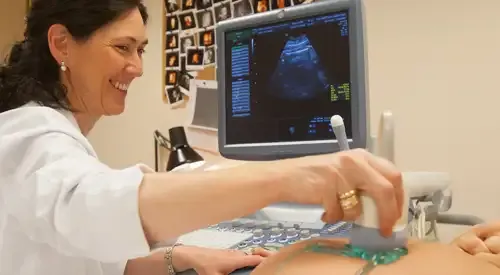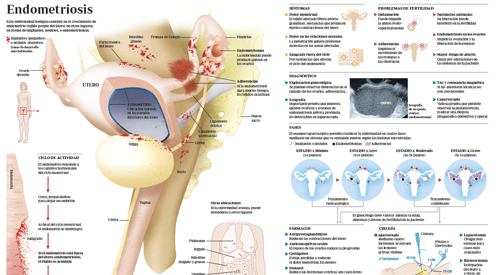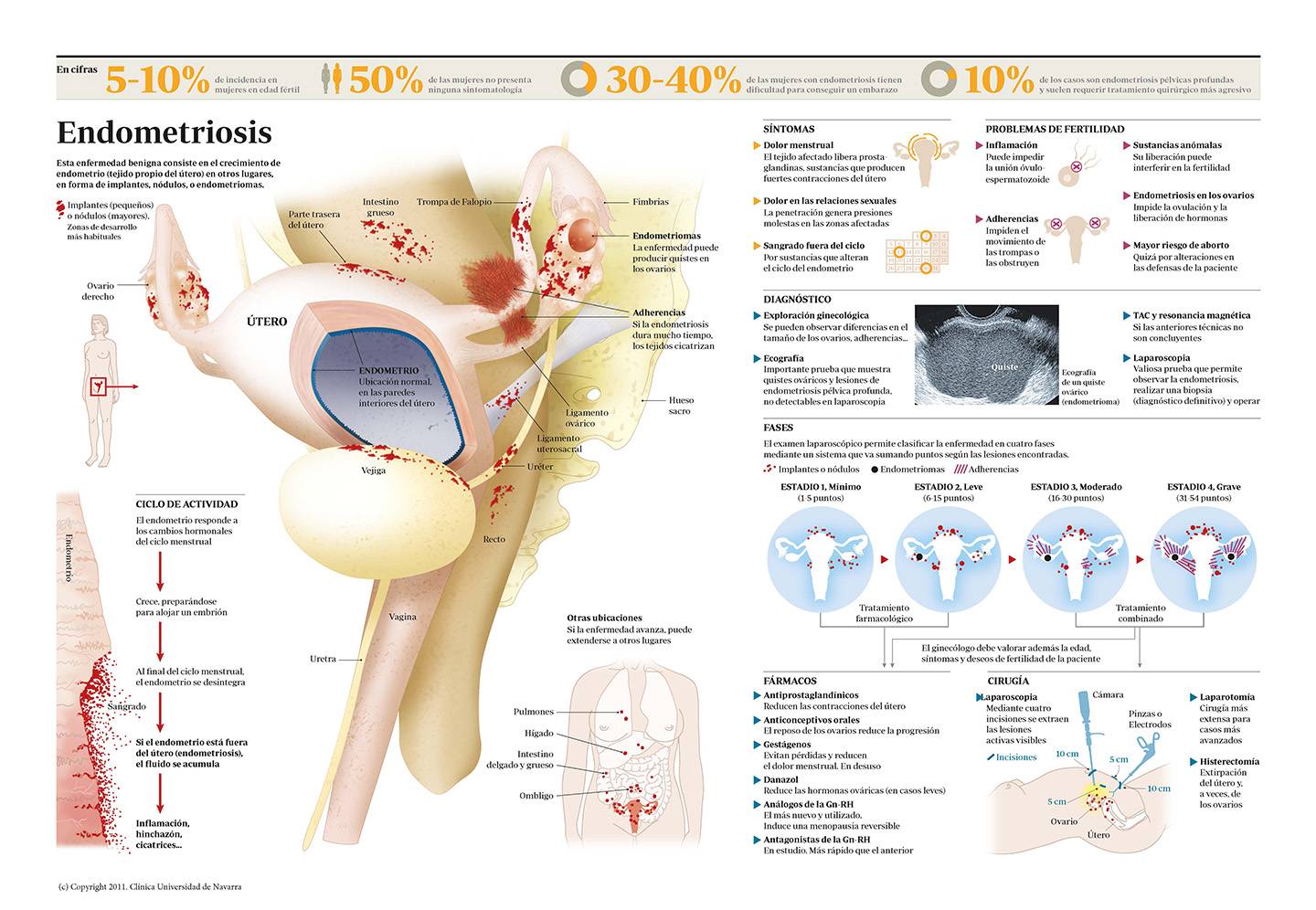Endometriosis
"The success of its control lies in a prompt diagnosis, in a correct medical-surgical management and in an effective, but scarcely aggressive, approach".
DR. LUIS CHIVA
DIRECTOR - PERSON IN CHARGE. GYNAECOLOGY AND OBSTETRICS DEPARTMENT

What is endometriosis?
Endometriosis is a benign disease that affects women during their reproductive lives.
If the endometrium, which is located outside the uterus, develops incorrectly, it can settle anywhere in the abdomen. It can cause implants (small plaques), nodules (large plaques) and endometriomas (cysts in the ovaries).
Endometriosis is a process of unpredictable evolution. Some women have small implants that do not change, while in others it can develop extensively within the pelvis. It is an inflammatory disease, which in turn causes adhesions between organs.

What are the symptoms of endometriosis?
Dysmenorrhea or menstrual pain
This is secondary dysmenorrhea, which appears later than in the first months of the menstrual cycles, increases over time and is accompanied by other symptoms typical of endometriosis. This pain is usually due to the formation of prostaglandins, which cause strong uterine contractions.
Dyspareunia or pain with sexual intercourse
Vaginal penetration can put pressure on some areas affected by endometriosis: ovaries, vaginal ceiling and utero-sacral ligaments.
Abnormal uterine bleeding
Many women with endometriosis have no menstrual changes or leakage between periods, but the endometrial cycle can be altered and small extemporaneous leakage can occur.
Reproductive problems
In some women sterility or infertility is the reason for consultation that allows the diagnosis of endometriosis.
Endometriosis can cause infertility by
- Inflammation in the abdomen that prevents the union of the egg and sperm.
- Pelvic adhesions that prevent normal movement of the tubes and even obstruct them.
- Endometriosis in the ovaries that prevents normal ovulation and the manufacture of sex hormones.
- Secretion of unusual substances in the abdomen that hinder the normal process of fertility.
- Women with endometriosis have a higher risk of miscarriage, which decreases once the disease is corrected.
Do you have any of these symptoms?
Endometriosis may be present
What are the causes of endometriosis?
To this day, the cause of endometriosis is still unknown.
Some specialists defend that a part of the menstruation runs through the tubes and falls into the abdomen instead of being expelled to the outside. However, this occurs in many women who do not develop endometriosis.
Another cause may be a possible defect in immunity responsible for cleaning up microbes and abnormal cells in the abdomen. The defenses are of lower quality and this would prevent them from recognizing endometrial cells as foreign (usually only inside the uterus) and leaving them free to be planted in the internal organs.
On the other hand, there are families with a mother and several sisters affected by endometriosis, so there may be a hereditary component.
Fertility after endometriosis
Endometriosis does not always affect fertility, so a woman can become pregnant before surgical treatment.
However, if in addition to the symptoms, the reason for the consultation is sterility, there is no absolute guarantee of pregnancy after surgery.
However, it can be assured that the possibility of becoming pregnant, in the absence of other factors, increases notably just after medical and/or surgical treatment, which is why this will always be advisable.
Pregnancy has a protective effect on the development of future endometriosis. The ovaries are kept at rest during gestation, without secretion of female hormones. However, a patient should never be advised to become pregnant in order to better control her problem.
Endometriosis is a disease of increasing incidence. Improvement and pregnancy rates differ according to centers, and it is these data that should be offered to women.
How is endometriosis diagnosed?

Ultrasound is the basic technique that initially aims at diagnosing endometriosis. The image is relatively typical: ovarian cysts with a specific pattern.
Blood tests are also performed, although it is not a test that is routinely used in the diagnostic protocol. Recent studies point to an increase in the CA-125 marker in the blood of women with endometriosis, but it is non-specific because not all women with endometriosis have alterations in this marker.
Laparoscopy is an operative technique that allows observation of the inside of the abdomen. In young patients, especially if the objective is fertility, the aim is to eliminate the disease while preserving as much healthy tissue as possible.
In patients from 45-50 years, the proposal is to eliminate both ovaries to prevent malignant degeneration.
When the diagnosis of endometriosis by ultrasound is not clear or when the CA-125 marker is very altered, the gynecologist can request special explorations: CT or MRI.
How is endometriosis treated?
The success of its control lies in a prompt diagnosis, in a correct medical-surgical management and in an effective approach.
Surgical techniques
- Laparoscopy, to remove endometrial growths.
- Laparotomy, more extensive surgery to remove all the endometrium that is out of place.
- Hysterectomy, removal of the uterus and possibly the ovaries.
Other treatments
The antiprostaglandins, anti-inflammatory to treat dysmenorrhea, oral contraceptives, which help to remit some of the symptoms, menstrual pain and reduce heavy periods
Gestagens
Danazol, which decreases the levels of ovarian hormones, thus generating a pseudomenopause
Gn-RH analogues (gonadotropin-releasing hormone)
Substances that act at the brain level: this is the newest medication. It suppresses more intensely the genesis of hormones from the ovary and causes a reversible menopause when you stop taking this medication Gn RH antagonists, in experimental studies Their objective is to achieve a temporary menopause from the first administration.
Where do we treat it?
IN NAVARRE AND MADRID
The Department of Gynecology and Obstetrics of the
of the Clínica Universidad de Navarra
Comprehensive care that includes a wide range of consultation and treatment options from regular preventive screening to the most advanced diagnostic and treatment options for obstetric and gynecological problems at all ages.
The department also offers routine pregnancy monitoring that includes a variety of diagnostic and screening procedures to identify potential problems of the fetus as well as its proper growth and development.
Diseases we treat
- Gynecological Cancer
- Prenatal diagnosis
- Endometriosis
- Urinary and fecal incontinence
- Masas anexiales
- Menopause
- Polycystic ovary syndrome
- Uterine Myomas

Why at the Clinica?
- Highly specialized team of doctors, nurses and midwives.
- Reproduction and Fertility Unit.
- Pregnancy follow-up with a personalized delivery.
- All the comfort, with the guarantee and safety of a hospital with the most advanced equipment.



























